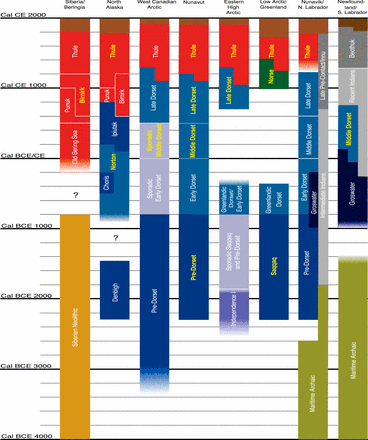Maanasa Raghavan, Michael DeGiorgio, Anders Albrechtsen, Ida Moltke, Pontus Skoglund, Thorfinn S. Korneliussen, Bjarne Grønnow, Martin Appelt, Hans Christian Gulløv, T. Max Friesen, William Fitzhugh, Helena Malmström, Simon Rasmussen, Jesper Olsen, Linea Melchior, Benjamin T. Fuller, Simon M. Fahrni, Thomas Stafford Jr., Vaughan Grimes, M. A. Priscilla Renouf, Jerome Cybulski, Niels Lynnerup, Marta Mirazon Lahr, Kate Britton, Rick Knecht, Jette Arneborg, Mait Metspalu, Omar E. Cornejo, Anna-Sapfo Malaspinas, Yong Wang, Morten Rasmussen, Vibha Raghavan, Thomas V. O. Hansen, Elza Khusnutdinova, Tracey Pierre,:Kirill Dneprovsky, Claus Andreasen,:Hans Lange,:M. Geoffrey Hayes, Joan Coltrain, Victor A. Spitsyn, Anders Götherström, Ludovic Orlando, Toomas Kivisild, Richard Villems, Michael H. Crawford, Finn C. Nielsen, Jørgen Dissing, Jan Heinemeier, Morten Meldgaard, Carlos Bustamante, Dennis H. O’Rourke, Mattias Jakobsson, M. Thomas P. Gilbert, Rasmus Nielsen, and Eske Willerslev
Source - http://www.sciencemag.org/content/345/6200/1255832
Humans first peopled the North American Arctic (northern Alaska, Canada, and Greenland) around 6000 years ago, leaving behind a complex archaeological record that consisted of different cultural units and distinct ways of life, including the Early Paleo-Eskimos (Pre-Dorset/Saqqaq), the Late Paleo-Eskimos (Early Dorset, Middle Dorset, and Late Dorset), and the Thule cultures.

Fig. 1Chronology of the prehistoric cultures in the New World Arctic and northeast Siberia.
This framework is based on a combination of screened radiocarbon dates on associated terrestrial materials, typological studies, and contexts [e.g., (6, 9, 37, 40, 83–85)]. Fading colors symbolize uncertainties concerning the beginnings or ends of the archaeological cultures, owing to plateaus or wiggles in the radiocarbon calibration curve or lack of data. Defined archaeological phases within a culture are separated by a white line. Dark reddish-brown toward the top of the figure indicates historical times. Cultural contexts from which samples included in this study arise are highlighted in yellow.
Genetic origins of Paleo-Eskimos and Neo-Eskimos. All Paleo-Eskimos represent a single migration pulse from Siberia into the Americas, independent of the Neo-Eskimo Thule people (ancestors of modern-day Inuit) and the related extinct Sadlermiut population. The Siberian Birnirk people were likely cultural and genetic ancestors of modern-day Inuit. We also show ancient admixture between the Paleo- and Neo-Eskimo lineages, occurring at least 4000 years ago.
Rationale
We addressed the genetic origins and relationships of the various New World Arctic cultures to each other and to modern-day populations in the region. We obtained 26 genome-wide sequences and 169 mitochondrial DNA sequences from ancient human bone, teeth, and hair samples from Arctic Siberia, Alaska, Canada, and Greenland, and high-coverage genomes of two present-day Greenlandic Inuit, two Siberian Nivkhs, one Aleutian Islander, and two Athabascan Native Americans. Twenty-seven ancient samples were radiocarbon dated for accurate cultural assignment, of which 25 were corrected for marine reservoir effect to account for the dominant marine component in these individuals’ diets.
Results
Nuclear and mitochondrial DNA data unequivocally show that the Paleo-Eskimos are closer to each other than to any other present-day population. The Thule culture represents a distinct people that are genetic and cultural ancestors of modern-day Inuit. We additionally find the Siberian Birnirk culture (6th to 7th century CE) as likely cultural and genetic ancestors of the Thule. The extinct Sadlermiut people from the Hudson Bay region (15th to 19th century CE), considered to be Dorset remnants, are genetically closely related to Thule/Inuit, rather than the Paleo-Eskimos. Moreover, there is no evidence of matrilineal gene flow between Dorset or Thule groups with neighboring Norse (Vikings) populations settling in the Arctic around 1000 years ago. However, we do detect gene flow between the Paleo-Eskimo and Neo-Eskimo lineages, dating back to at least 4000 years.
Conclusion
Our study has a number of important implications: Paleo-Eskimos likely represent a single migration pulse into the Americas from Siberia, separate from the ones giving rise to the Inuit and other Native Americans, including Athabascan speakers. Paleo-Eskimos, despite showing cultural differences across time and space, constituted a single population displaying genetic continuity for more than 4000 years. On the contrary, the Thule people, ancestors of contemporary Inuit, represent a population replacement of the Paleo-Eskimos that occurred less than 700 years ago. The long-term genetic continuity of the Paleo-Eskimo gene pool and lack of evidence of Native American admixture suggest that the Saqqaq and Dorset people were largely living in genetic isolation after entering the New World. Thus, the Paleo-Eskimo technological innovations and changes through time, as evident from the archaeological record, seem to have occurred solely by movement of ideas within a single resident population. This suggests that cultural similarities and differences are not solid proxies for population movements and migrations into new and dramatically different environments, as is often assumed.
Read the Full Text